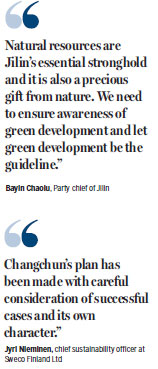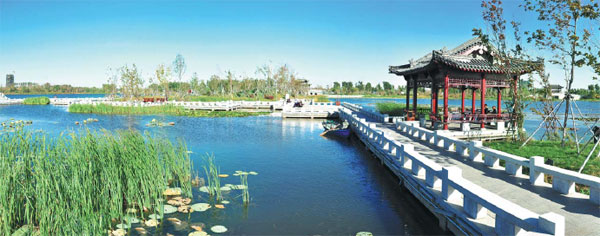Focus on smart, eco-friendly growth
Changchun, a northeastern city rising out of the cold soil in Jilin province, is accelerating the pace of its environmental development by building Changchun New Area.
Following the call of the 13th Five-Year Plan (2016-20), the city aims to accelerate its transformation from an industrial town into a modern environmental smart city.
Even though it is built on the frozen soil, Changchun bears the title "city of spring" in Northeast China.
Literally meaning "long-lasting spring", Changchun is a monsoon-prone city with four distinct seasons, with winter usually lasting for five months.
Changchun has also long been regarded as China's City of Automobiles or China's Detroit, because of its large industrial bases, focusing on automotive production.

But now the city is chasing after another name, that of an eco-friendly city with a combination of greener urban design, a low-carbon lifestyle and well preserved natural resources in its newly-planned area.
Jilin needs to push its ecological civilization, strengthen counter measures against pollution, promote clean energy and expand its green land, said President Xi Jinping during a recent trip to Jilin.
The goal is to make the sky bluer, the land greener and the water cleaner, to create a better environment, he added.
Ecological civilization is a new concept proposed by former president Hu Jintao as future-oriented guidance for development, recognizing the damage already done to the environment by the mushrooming economy.
Throughout the past decade, Northeast China's economy has boomed at the cost of the environment, interrupting the balance between economy and ecology.
For example, heavy industries' layout was planned without taking into consideration the impact on the environment.
The exploitation of resources exceeded the environment's capacity.
Boosting the economy without substantial damage to the environment is the major obstacle in the progress of urbanization.
Jilin government believes that the key to solving this problem is to achieve maximum efficiency, through quality space and resources.
"Natural resources are Jilin's essential stronghold and it is also a precious gift from nature," said Bayin Chaolu, Party chief of Jilin. "We need to ensure awareness of green development and let green development be the guideline," he added.
At present, Changchun is working toward becoming a major city in Northeast Asia. The recently approved Changchun New Area development plan covers the period of 2016-30.
Its main strategy will echo the Belt and Road Initiative in order to revitalize Northeast China and the National New-type Urbanization Plan, and finally aim to build an ecological city up from foundations in the frozen land.
Piloting a cold region eco-system
Based on its particular climate and geological conditions, Changchun has adapted its development to reflect that of other established cities, such as Vancouver, Canada, and Freiburg, Germany.
Vancouver experienced a similar dilemma to that which Jilin is currently facing: over-exploitation of natural resources to meet the demand from its automotive industry.
This led to environmental damage in the western Canadian city. In 2009, Vancouver put forward a report called Vancouver 2020: A Brighter Green Future, to initiate and implement reforms.
Freiburg has also spent 40 years putting forward 41 action plans to transform itself into an eco-friendly city.
Jyri Nieminen, chief sustainability officer at Sweco Finland Ltd, quoted by Changchun Daily, confirmed that Changchun's approach is efficient. "Changchun's plan has been made with careful consideration of successful cases and its own character. It has taken ecology, environment and energy into consideration, and it covers all aspects of life, from living space, to manufacturing, transportation and administration."
"Urbanization is all about city planning," said Wang Junzheng, an official with the Standing Committee of Jilin Provincial Committee. "We need to learn from different advanced cities and aim for a better image, because city planning decides the future. We must build a respectful image of the city as well as focusing on living standards for residents," Wang added.
Changchun's new city plan learns from these established cities, but also considers its own qualities. Fast-paced urbanization can often lead to a large number of standardized urban cities.
However, according to the city's plan, Changchun New Area will work on preserving its own features and identity, such as its unique geological landscape shaped by long-lasting winters.
The concept of green development is the guiding principle for the city's plans. The plans have addressed issues such as how to build a low-carbon economy and improve residents' quality of life.
First, the city's pilot plan expects to boost recycling rates.
To tackle the lack of water sources in Changchun New Area, the self-cleaning and recycling capability of the water supply system will be enhanced to boost efficient water use.
Also, the area will reduce solid waste by establishing an end-to-end recycling system from waste collection, transportation, categorization and processing, to reduce the consumption of raw materials.
In addition, the new area will emphasize minimizing pollution by largely optimizing its energy structure, encouraging clean energy, reducing residential buildings' energy consumption and advocating the use of public transportation.
Furthermore, Changchun's new area will experiment with industrializing wooden structure architecture.
A relative industry union, a technology innovation center and a state-level lab will be set up in the near future.
To reduce air pollution, which is especially severe in Northeast China, the new area will optimize its gas and heating system to reduce emissions.
Also, the area will establish a thorough monitoring network for both noise pollution and the ecological environment, with improved regulation.
Changchun New Area sets its emphasis on both the environment and its residents.
By taking these needs into consideration, Changchun New Area has worked out its own approach to building an eco-friendly city and has established an example for other northeastern cities.
Shen Qingji, the doctoral supervisor at Tongji University's architecture and city planning department, spoke highly of Changchun New Area's plan: "Changchun New Area sets its emphasis on both the environment and residents. By taking these needs into consideration, the New Area has worked out its own approach to building an eco-friendly city and has established an example for other northern cities."
Protecting natural resources
Changchun New Area will spearhead a strategy to build a harmonious living space where human beings and the forest can co-exist.
The city's designers view the area as a whole rather than as separate segments.
Therefore, the use of farmland, the mountains, the forest and water sources will be systematically administrated by one department rather than separate offices working individually.
Planners of Changchun New Area believe that by authorizing one single office, the area will benefit from a cohesive and integrated design in which all parts work efficiently with each other, to better protect the ecosystem.
"Changchun New Area will make good use of its abundant natural resources of mountains, forests, lakes, rivers and farmland," said Wu Shunze, deputy head of the Ministry of Environmental Protection's reform office.
"It will concentrate on the improvement of the environment and human
It will make use of its abundant mountains, forests, lakes, rivers and farmland.
It looks to concentrate on the improvement of the environment and human wellbeing, and build an eco-friendly city in this cold region.
The new area will be constructed on the base of three geographic features: a green belt from Dahei Mountain, four river corridors across the city and multiple lakes.
The mountain area will be strictly protected and strategies such as "grain for green" will be implemented to increase forest coverage.
The new area will also dredge river channels and build an improved river net for better maintenance.
In the inner city, the new area will construct functional parks to extend the green space.
In the city's high-tech zone, residents will be able to spend leisure time in the forest park.
Along the riverside a number of parks will be preserved to provide habitats for wild birds.
Two more parks will be placed in the city to increase the capacity for retaining rainwater and to mitigate potential water logging.
Low-carbon lifestyles
Changchun New Area will also raise awareness of and encourage a low-carbon lifestyle, by increasing recycling rates, reducing consumption of traditional energy resources and promoting use of public transportation that operates on clean energy.
To make full use of its resources, especially household waste, an advanced recycling system will be established all over the city with a number of waste processing centers.
The aim is to create a closed recycling loop to achieve the maximum use of raw materials.
In addition, a series of regulations on architectural design will be put forward to conserve energy. In order to eliminate the urban heat island effect, large public buildings will be covered in green roofs.
The government will also work on bus routes and bicycle lane planning to promote a low-carbon system for commuters.
renxiaojin@chinadaily.com.cn
|
Children living in Changchun New Area enjoy a happy moment with a mother. The area is not only a top investment destination, but also a comfortable residential community. Provided to China Daily |
|
The Beihu Wetland Park covers 164,000 square meters in Changchun New Area. Provided to China Daily |
(China Daily 02/13/2017 page38)
















